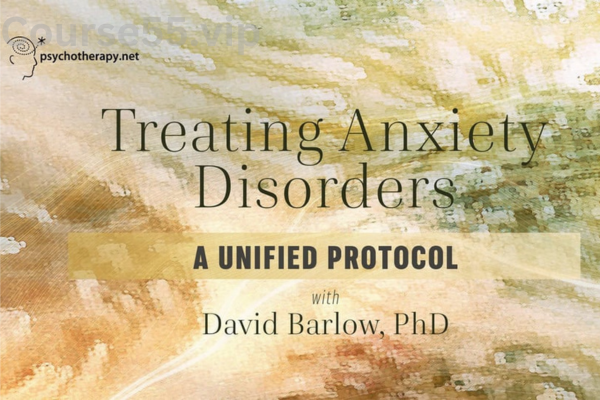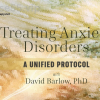Treating Anxiety Disorders A Unified Protocol with David Barlow
$49.00 Original price was: $49.00.$7.70Current price is: $7.70.
Treating Anxiety Disorders: A Unified Protocol with David Barlow – Digital Download!

Treating Anxiety Disorders A Unified Protocol with David Barlow
Overview

Navigating Anxiety Disorders: David Barlow’s Unified Protocol
Millions around the globe wrestle daily with the heavy burden of anxiety disorders, confronting persistent fear, worry, and uneasiness. In this challenging emotional landscape, conditions like generalized anxiety disorder (GAD) and obsessive-compulsive disorder (OCD) create formidable obstacles. Recognizing the overlap among these disorders, Dr. David H. Barlow introduced the Unified Protocol for Transdiagnostic Treatment of Emotional Disorders. Rather than focusing on disorder-specific treatments, this groundbreaking method offers a single, integrated framework. The Unified Protocol charts a course through shared emotional struggles, providing clinicians and patients with a unified therapeutic path across different anxiety conditions.
The Foundation Behind the Unified Protocol
Central to Barlow’s approach is the insight that although anxiety disorders present differently, they often arise from common emotional vulnerabilities. This transdiagnostic model reimagines anxiety treatment as a continuum instead of a collection of isolated diagnoses. With this understanding, clinicians can directly address the emotional roots contributing to a variety of mental health conditions.
The Unified Protocol organizes its methodology into five core modules, each aimed at managing key emotional traits linked to these disorders:
-
Managing Emotions: Teaching individuals effective strategies to handle intense emotional reactions.
-
Emotional Awareness: Training patients to recognize and interpret their emotional states for improved coping.
-
Reframing Thoughts: Helping patients identify and shift distorted thinking patterns that perpetuate anxiety.
-
Facing Fears: Guiding patients to confront their fears systematically, reducing tendencies toward avoidance.
-
Mindfulness Practice: Encouraging non-judgmental awareness of the present, fostering acceptance of emotional experiences.
By weaving these elements together, the Unified Protocol creates a dynamic and adaptable framework that transcends the limitations of single-disorder treatments.
A Closer Look at the Evidence: 2017 JAMA Psychiatry Findings
A landmark study validating the Unified Protocol’s effectiveness appeared in 2017 through JAMA Psychiatry. In a randomized clinical trial led by Barlow and his team, 223 participants with a variety of anxiety disorders—including panic disorder, GAD, OCD, and social anxiety disorder—were treated using the protocol. The outcomes revealed that this method was just as effective as traditional, diagnosis-specific treatments in lessening symptom intensity.
Major Insights from the Study:
-
Improved Treatment Adherence: Participants undergoing the Unified Protocol showed higher rates of completing treatment compared to those in disorder-specific programs, suggesting greater patient buy-in.
-
Significant Symptom Relief: Both approaches successfully reduced anxiety symptoms, underscoring the Unified Protocol’s broad therapeutic reach.
-
Lower Dropout Rates: The transdiagnostic method also achieved reduced attrition, addressing a chronic issue in therapy by helping keep patients engaged longer.
This research firmly establishes the Unified Protocol as a strong, evidence-supported alternative to standard treatment approaches.
Finding Commonalities in Emotional Struggles
Recognizing the shared psychological processes underlying different anxiety disorders enables a more universal application of therapy methods. Barlow’s Unified Protocol is built on the premise that many emotional challenges are interrelated rather than isolated problems requiring separate solutions.
Emotional Regulation: The Heart of the Unified Protocol
At the core of the Unified Protocol lies a focus on emotional regulation, guiding every therapeutic intervention across modules. Key elements include:
-
Recognizing Emotional Triggers: Helping patients become aware of situations that spark emotional distress, allowing proactive management.
-
Developing Coping Mechanisms: Providing tools to replace avoidance with healthier engagement in difficult situations.
-
Strengthening Resilience: As patients learn to navigate emotional turbulence, they build the confidence to confront future challenges more effectively.
This structure empowers patients to better navigate life’s inevitable emotional fluctuations with greater mastery and independence.
Unified Protocol Versus Disorder-Specific Approaches: A Comparative Lens
One of the Unified Protocol’s greatest strengths lies in its adaptability. Where conventional treatments often require custom-tailored approaches for each disorder, the Unified Protocol’s broader application offers considerable advantages in efficiency and practicality.
Comparison Table: Unified Protocol vs. Disorder-Specific Treatments
| Aspect | Unified Protocol | Disorder-Specific Treatments |
|---|---|---|
| Flexibility | High; usable across multiple conditions | Low; focused on individual disorders |
| Time Efficiency | Streamlined, reduces overall treatment time | Prolonged due to varying therapeutic plans |
| Cost-Effectiveness | Lower cost with a unified model | Higher cost with multiple targeted therapies |
| Patient Retention | Higher engagement and fewer dropouts | Often faces greater patient attrition |
The Unified Protocol moves beyond theory, offering a realistic, patient-centered approach to tackling emotional disorders in diverse settings.
Therapeutic Journeys: Emotional Growth for Patients and Clinicians
Understanding the mechanics of the Unified Protocol is only part of the story; experiencing it emotionally reveals a deeper layer. The healing journey often mirrors a winding river, with both calm stretches and turbulent rapids testing emotional resilience.
For patients, beginning therapy with the Unified Protocol can stir up apprehension, as revisiting painful memories is rarely easy. Yet as they progress through techniques like cognitive restructuring and controlled exposure, they often find reassurance in shared emotional experiences. This sense of collective struggle fosters a community spirit crucial for recovery.
Clinicians, too, undergo a transformative process. Embracing the Unified Protocol means adopting a wider, more inclusive perspective on treatment, encouraging professional growth while forging deeper emotional connections with patients. Witnessing patients thrive through a shared framework becomes a deeply rewarding experience.
Final Thoughts
In an era marked by rising rates of anxiety disorders, the Unified Protocol for Transdiagnostic Treatment of Emotional Disorders emerges as a guiding light. Dr. David Barlow’s visionary model provides a thorough understanding of anxiety’s core dynamics and a flexible, cohesive treatment structure. Supported by strong research and centered around the universality of emotional experiences, the Unified Protocol offers a way forward for both patients and clinicians. By bridging gaps among different disorders, it not only enhances therapeutic outcomes but also strengthens resilience and rekindles hope for those navigating the complexities of emotional healing.
Frequently Asked Questions:
Business Model Innovation: We operate a group buying strategy, allowing participants to share costs and access popular courses at reduced prices. This model benefits individuals with limited financial resources, despite concerns from content creators about distribution methods.
Legal Considerations: The legality of our operations involves complex issues. Although we don’t have explicit permission from course creators to resell their content, there are no specific resale restrictions stated at the time of purchase. This ambiguity creates an opportunity for us to provide affordable educational resources.
Quality Control: We ensure that all course materials purchased are identical to those offered directly by the creators. However, it’s important to understand that we are not official providers. As such, our offerings do not include:
– Live coaching calls or sessions with the course author.
– Access to exclusive author-controlled groups or portals.
– Membership in private forums.
– Direct email support from the author or their team.
We aim to reduce the cost barrier in education by offering these courses independently, without the premium services available through official channels. We appreciate your understanding of our unique approach.
Be the first to review “Treating Anxiety Disorders A Unified Protocol with David Barlow” Cancel reply
You must be logged in to post a review.

















Reviews
There are no reviews yet.